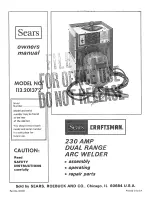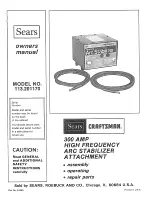
32
32
G
B
The DIP 5 in the OFF position disables any pre-flashing, the BLINKER starts flashing
and the motors will start at the same time.
BUZZER
The current supplied to the Buzzer will be 200 mA at 12Vdc.
During the normal operation of the gate, opening and closing, the buzzer will buzz
intermittently. Only during the alarm situations (safety strip) the buzzing will almost be
constant.
GATE OPEN INDICATOR (SIGNAL - COM)
Should you need to have an indication about the leaf position, the output SIGNAL -
COM can be connected to a 12Vdc bulb of 3W maximum. It is turned ON when the
gate is open or partially open, it is turned OFF only when the gate is completely closed.
WE RECOMMEND NOT TO OVERLOAD THE INDICATOR OUTPUT (SIGNAL -
COM) OTHERWISE THE GATE FUNCTIONING COULD BE COMPROMISED OR
THE CONTROL BOARD COULD BE DAMAGED
RESTORATION OF OPERATIONS AFTER A BLACKOUT
If DIP 11 is turned OFF the blackout function is DISABLED.
If DIP 11 is turned ON the blackout function is ENABLED.
In case of a blackout occurs and the blackout function is enabled (DIP11 ON), when
the main power returns, automatically the operator will function according to the chart 1.
T
ECHNICAL SPECIFICATIONS
- Humidity
< 95% without
condensation
- Power supply voltage
230 o 120V~ ±10%
- Frequency
50/60 Hz
- Maximum absorption
32 mA
- Interruptions in electricity supply
100ms
- Maximum power of gate open indicator
12Vdc 3W (equivalent to
1 bulb of 3W or 5 LED
with serial resistance of
2,2 kΩ)
- Maximum load of blinker output
40W with resistive charge
- Current available for photocells and accessories
500mA 12Vdc
- Current available on radio connector
200mA 12Vdc
TECHNICAL RADIO SPECIFICATIONS (Only CRX models)
- Reception frequency
433,92MHz
- Impedance
52 Ω
- Sensitivity
>2.24µV
- Excitation time
300ms
- De-excitation time
300ms
- Codes in store
N° 62
- All the inputs must be used as clean contacts because the power supply is generated
internally (safe voltage) in the card and it is set in a way to guarantee the use of the
double insulation and reinforced in relation to parts with hazardous voltage.
- Any external circuits connected to the outputs of the control board, must be carried
out to make sure the double or reinforced insulation is used in relation to parts with
hazardous voltage.
- All the inputs are run by a programmed integrated circuit which carries out a self-
check at the beginning of each operation.
During blackout
At the return of the network
power supply.
If the gate is totally closed
It will remain closed
If the gate is at the opening stage
It will continue opening
If the gate is totally open (with dip 3 OFF)
It remains open. Consequently
closing operations of the gate
can be controlled.
If the gate is totally open (with dip 3 ON)
It remains open, but at the
expirery of the automatic
closure time closure operation
starts off.
If the gate is in the closure stage
It continues closing.
If the gate is in the safety edge alarm
The safety edge alarm starts
off again.
chArT 1
T
ROUBLE SHOOTING
After having carried out all connections, by carefully following the layout and having positioned the gate in intermediate position, check the correct ignition of
LEDS DL7, DL8.
In case of no ignition of the LEDS, always with gate in intermediate position, check the following and replace any faulty components.
DL7 switched off
Faulty photocells
DL8 switched off
Faulty safety edge (In case the edge is not connected, carry out jumper between COM and EDGE)
During functioning with personnel present, with DIP 1 at ON, check that during opening of M1 and M2 the green DL5 and DL3 LEDS switch on and that during
closing of M1 and M2 the red DL6 and DL4 LEDS switch on.
If not, invert clamps V and W on the motor terminal board of the interested motor.
After having carried out the various connections and having supplied voltage, all the LEDS
are switched off.
The motor opens and closes, but it has no strength and moves slowly.
The gate opens but does not close after the time set.
The gate does not open or close by activating the various K and RADIO buttons.
By activating the K button the gate does not move.
The electric lock does not work.
Check the integrity of fuses F1 and F2. In case of interrupted fuse use only of
adequate value F2 = 5A F1 = 100mA.
Check trimmers TORQUE and LOW-SPEED adjustment.
Ensure to have set DIP 3 at ON. Button K BUTTON always inserted in automatic
functioning mode (DIP 6 OFF). Replace button or switch of the selector switch.
Failed edge self-test => check the connections between electronic board and edge
feeder.
Attention:
if not using a feeder for edges, DIP 10 must be at OFF position.
Faulty safety edge contact. Faulty photocells contact with DIP 4 OFF.
Fix or replace the relative contact.
Impulse K always inserted. Check and replace any buttons or micro-switches of the
selector switch.
Ensure to have enabled DIP 8 at ON.
FAULT
SOLUTION































